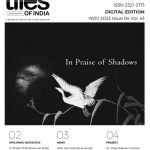Japanese author Junichiro Tanizaki’s book ‘In Praise of Shadows’ is a 1933 essay on Japanese aesthetics.
Design is a world of aesthetics, a play between light and shadow and form and function. From time immemorial humankind has been mesmerized with this and it plays a huge role in how design takes form even in the most contemporary settings.
There are thinkers and creators who have left an indelible mark on this topography, one of whom is Japanese author Junichiro Tanizaki. His book ‘In Praise of Shadows’ is a 1933 essay on Japanese aesthetics. It was translated into English, in 1977, by the academic students of Japanese literature Thomas J. Harper and Edward Seidensticker. A new translation by Gregory Starr was published in 2017. The 102-page edition also includes a foreword by the Japanese architect Kengo Kuma and an afterword by Japanese literature Professor Eve Zimmerman of Wellesley College.
The book is a small meditative work of 73 pages, of which 59 are the essay itself.
The essay consists of 16 sections that discuss traditional Japanese aesthetics in contrast with change. Comparisons of light with darkness are used to contrast Western and Asian cultures. The West, in its striving for progress, is presented as continuously searching for light and clarity, while the subtle and subdued forms of East Asian art and literature are seen by Tanizaki to represent an appreciation of shadow and subtlety, closely relating to the traditional Japanese concept of Sabi. In addition to contrasting light and dark, Tanizaki further considers the layered tones of various kinds of shadows and their power to reflect low-sheen materials like gold embroidery, patina and cloudy crystals. In addition, he distinguishes between the values of gleam and shine.
The text presents personal reflections on topics as diverse as architecture and its fittings, crafts, finishes, jade, food, cosmetics and mono no aware (the art of impermanence). Tanizaki explores in close description the use of space in buildings, lacquerware by candlelight, monastery toilets, and women in the dark of a brothel. The essay acts as “a classic description of the collision between the shadows of traditional Japanese interiors and the dazzling light of the modern age”. There are sixteen section themes on construction, the toilet aesthetic, reflections in darkness and such. Tanizaki’s observations include cultural notes on topics such as arts and crafts, paper making, lacquerware design and the Japanese room.
He gives a recipe for the unusual dish of Persimmon Leaf Sushi on pages 60 to 62. He also refers to many historic places and temples, as well as celebrated eateries of the day, along with customs like “moon-viewing” (tsukimi). The work has been praised for its insight and relevance into issues of modernity and culture and has been described as a “hymn to nuance” and an exercise in mindfulness.
Junichiro Tanizaki writes about the delicate and nuanced, softened by shadows and the patina of age, anything understated and natural—as for example the patterns of grain in old wood, the sound of rain dripping from eaves and leaves, or washing over the footing of a stone lantern in a garden, and refreshing the moss that grows about it – and by doing so he suggests an attitude of appreciation and mindfulness, especially mindfulness of beauty, as central to life lived well.
An intimate reflection on Japanese art and architecture from a great novelist, this book has inspired Japanese architects and designers from all over the world with its unique perspective on mindful Japanese aesthetics and remains an eternal favourite.
Content and images from various internet resources




GIPHY App Key not set. Please check settings